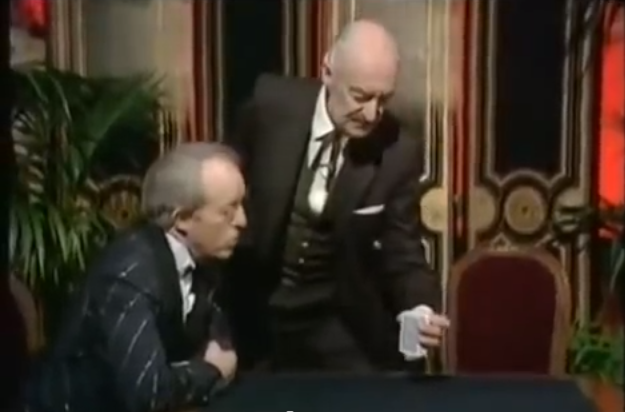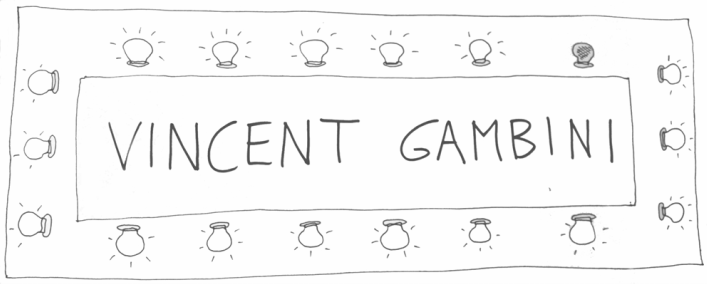
I’m starting research and rehearsals on a new trick. But first a little prologue.
I recently found out that one of the greats of close-up magic, the Argentinean René Lavand, passed away earlier in 2015. I was shocked and very much saddened.
Lavand was many magicians’ favourite magician. Mention his name to most prestidigitators, and you will see eyes light up and chests heaving with heartfelt admiration: as far as performers go, Lavand was perhaps the best magician of the 20th century.
To my mind, his work is a kind of performance poetry with objects. What strikes me, again and again, are the particular rhythms that he would set in motion, rhythms that have a lot to do with the relation between speech and actions, and a canny use of repetition. His pieces worked like incantations, often driving simple ideas through sophisticated rhetorical and gestural motifs.
The trick in question was Lavand’s signature piece. Entitled ‘No se puede hacer mas lento’ (It can’t be done any slower), it is his equivalent of, let’s say, Michael Jackson’s Billy Jean, or Keith Jarrett’s The Koln Concert. Arguably his best known work, and probably for good reason.
So the question for me now is: why on earth would I, or anyone else, try to reproduce this trick? Surely I cannot match the ‘original’, and so why perform a ‘copy’?
I am thinking along the lines of a cover, to use a musical term. I’d like to do a cover version of Lavand’s signature card trick, in which 3 red cards and 3 black cards are slowly positioned in alternate order (black, red, black, red, black, red), only to be turned over to reveal that the colours are unmixed. This is done a total of 5 times, each time the trick growing more impossible, and each revelation accompanied by Lavand’s famous exhortation: ‘No se puede hacer mas lento!’ (It can’t be done any slower).
Some questions I am considering are: what needs to be kept to constitute a cover, and what can be, or needs to be, modified?
I already adapted one of Lavand’s tricks, effectively making a new trick out of it (his ‘El Griego’ formed the basis of my ‘Neuromagic’, in which four cards turn white on both sides).
However for this trick I think it’s crucial that the handling and execution mirror Lavand’s. And since he famously only had the use of his left hand, having lost his right hand in a childhood car accident, this means learning to perform the trick one handed (I’ve been practicing daily for the past month, spurred by a minor case of Repetitive Strain Injury on my right forearm).
I don’t want to do the trick “as Lavand”, or even imitate his manner of speech. It would jar to have Gambini – a kind of tongue in cheek ironic magician – suddenly launch into Lavand’s poetic oration, which features solemnly delivered lines such as “There is nothing more nebulous than the truth…” I could never deliver this line with a straight face. So how to re-present this piece, without making a mockery of the original, or forgoing my own stylistic preferences?
Here’s the snag about this whole pursuit: there is something about the straightforward tribute that never works well for me in a live performance. Just like a small town tribute act (no offense to small town tribute acts), whenever a performer does a tribute they end up undermining both themselves and the original. Perhaps the tribute is a rather dubious creative pursuit: it leaves the performer “hiding” somewhat behind the imitation, and it potentially cheapens the original precisely by trying to recreate it.
A cover, however, is very different from a tribute: the cover typically takes an existing piece, and adapts it, responds to it, enters into dialogue with it, perhaps kicks it around a little, or reframes it, and turns it to other uses. I think of PJ Harvey’s fantastically skewed rendition of Bob Dylan’s Highway 61 Revisited. https://www.youtube.com/watch?v=D3CIK5SoTio If you can’t improve on a song that is superb, and superbly well known, you might as well take it out to graze in unknown pastures.
Whereas a tribute implies narrow subservience – a little like prostrating at the feet of a beloved but inescapable father figure – the cover allows more room for encounter, manoeuvre, and transformation.
I don’t know how Lavand’s piece will mutate, if at all. I know there won’t be a framed photograph of him in the show, no speeches about what a great magician he was.
Perhaps the tribute lies precisely in carrying his piece forward, and transmuting it into a new shape, yet retaining some essential feature of the original.
A long blog entry, but do stay tuned, and if you wish to see the “original”, here’s a link to Lavand performing it on an early Paul Daniels show (time signature 3:53 - 7:43) https://www.youtube.com/watch?v=k1ERjYyKvVU
Now be well
VG

 RSS Feed
RSS Feed